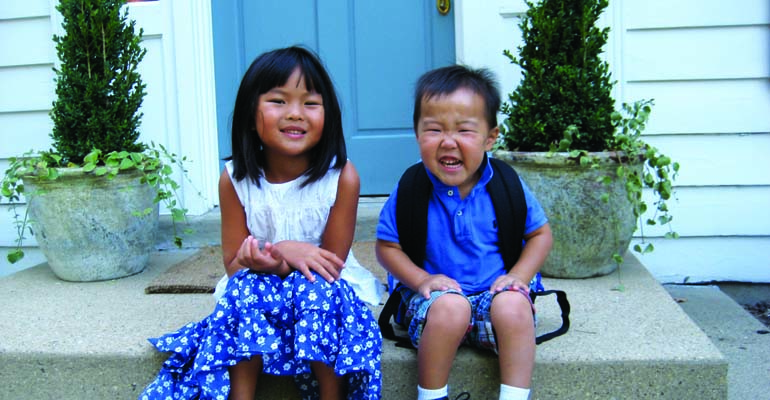When my oldest son, Keith, was in kindergarten, I volunteered in his classroom. The first time or two, I noticed confused looks on some of his classmates’ faces when he ran over to give me a big hug. Then I heard some of them whisper to Keith, “Is she your mom?” He probably didn’t understand why he was getting the third degree about me. I knew that it was because they assumed Keith’s mom would look like him, with dark skin, dark brown eyes, and black hair.
The next year, I approached Keith’s first-grade teacher early on to ask if I could do an adoption presentation. I decided I needed to do this now, before Keith was older, and, therefore, embarrassed to have his mom in the classroom. His teacher was enthusiastic.
To prepare, I read articles from Adoptive Families [find resources here], posted on forums asking for suggestions, and spoke to other adoptive parents. I was shocked that many were appalled that I would do this presentation at all, believing that it’s the child’s story to share and that I would just embarrass him. But I couldn’t see how educating my son’s classmates and teacher would be harmful. The week before the presentation, I ran the idea by Keith. He said, “We need to tell them that families do not have to look alike.”
Two Lists
When I arrived at school on the morning of the presentation, I got a big hug from Keith. He showed me to a rocking chair in front of all the children, who were sitting on the floor. He sat in a smaller chair next to me. I have never seen him sit so tall and proud as when he introduced me.
I began by telling the children that I was going to talk about the word “adoption.” Maybe they had heard it related to dogs, cats, or even roads, but babies were adopted, too. Some of the children nodded knowingly, but it was obvious that some were hearing this for the first time.
Then I pulled one of my daughter’s dolls out from my bag. I announced that her name was Maria, and that I wanted us to make two lists about her. One I labeled “Parents Do” and the other “Baby Needs.” For the “Parents Do” list, the children said “give baths,” “hold her,” “feed her,” “change her diapers,” “give hugs,” and “put clothes on her.” For “Baby Needs,” their responses included “diapers,” “bottles,” “binkies,” “a crib,” “clothes,” and “love.”
I told the class that they did an excellent job and that we had made wonderful lists. But we did forget one thing on the “Parents Do” list that is pretty important, and I added “bring a baby into the world.”
Two Sets of Parents
Some parents can bring babies into the world, I said, but can’t provide the other things on our lists. “But why?” some children asked. The reasons are always big, grown-up reasons, I replied, and never, ever have to do with the baby. These parents know that their grown-up reasons are too big, so they need to find another family to adopt and care for the baby. Then the baby has two sets of parents. The family that adopts her is her forever family — her everyday parents — but she also has the birth parents who brought her in to the world.
One girl asked who Keith’s birth parents were. I began to say that I wasn’t going to discuss Keith’s adoption. But Keith interrupted me with, “It’s OK, Mom,” and went on to tell her their names. I’d been told by some adoptive parents that children would not want to discuss their adoption details with classmates, but my son demonstrated his pride in the way he was brought into life, and into our family. What a wonderful adoption advocate he was becoming!
Choco and Mrs. Bear
The second part of my presentation included reading one of my all-time favorite adoption books, A Mother for Choco, by Keiko Kasza. It’s the story of a bird trying to find his mother, whom he assumes has to look like him. In the end, he finds a loving home with Mrs. Bear. Choco realizes that being a family isn’t about looks, but rather how you act toward one another.
The class recognized the correlation between the motherly actions of Mrs. Bear and the list they had made for what “Parents Do.” No one had suggested that a parent should look like her child when we compiled our list, I pointed out. Next to me, Keith piped up, “Yeah. We don’t look anything alike but we’re a family.”
At the end of the presentation, the teacher explained to the class why a fellow teacher missed the first six weeks of school — she had just adopted a child. I could see in the children’s faces that they understood. Some said, “She’s just like Mrs. Bear!”
I walked out of Keith’s class satisfied with my talk. There was neither awkwardness nor embarrassment. My intentions were to educate my son’s classmates and teacher, and I felt that I had. Most important, I saw what an amazing role model of transracial adoption my son is, and I couldn’t be more proud of him.



